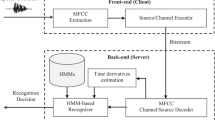Abstract
This study is specifically concerned with the statistical analysis of the Arabic phonemes due to its significant role in continuous Arabic Speech Recognition System (ASR). When building Arabic speech recognizer , the number of frames that a phoneme occupy, the phoneme boundary and the number of Hidden Markov Model necessary to represent the phoneme are greatly helpful in enhancing the recognition accuracy. In this paper we statically analyze KACST-5 hours corpus, which was used in Arabic speech recognition for both training and recognition. The results showed different set of tables and figures that are helpful for Arabic speech researchers. The paper comes up with a clustering graph for Arabic phonemes based on the median and a trigram table for all phonemes which represent the frequency of a phoneme to appear in trigram. The study was consistent and agreed with Arabic speech scientist’s observations.
Access this chapter
Tax calculation will be finalised at checkout
Purchases are for personal use only
Preview
Unable to display preview. Download preview PDF.
Similar content being viewed by others
References
He, X., Deng, L.: Discriminative Learning for Speech Recognition. Theory and Practice. Morgan & Claypool (2008)
AbuZeina, D., Al-Khatib, W., Elshafei, M., Al-Muhtaseb, H.: Cross-word arabic pronunciation variation modelin for speech recognition. International Journal of Speech Recognition 1381 (2011)
Al-Zabibi, M.: Acoustic-phonetic approach in automatic Arabic speech recognition. PhD thesis (1990)
Maalyl, I.A., Elobeid, A.R., Ali Ahmed, K.M.: New parameters for resolving acoustic confusability between Arabic phonemes in a phonetic HMM recognition system. WIT Press, Ashurst Lodge (2002) 1-85312-925-9
Ali, M., Elshafei, M., Al-Ghamdi, M., Al-Muhtaseb, H., Al-Najjar, A.: Arabic Phonetic Dictionaries for speech recognition. Journal of Information Technology 2, 80 (2009)
Ronald, E.W., Raymond, H.M., Sharon, L.M., Keying, Y.: Probability & Statistics for Engineers & Scientists. Pearson Prentice Hall, cop., Upper Saddle River (2007) 0132047675 9780132047678
Ahmed, M.E.: Toward an Arabic Text-to-Speech System. The Special Issue on Arabization. The Arabian Journal of Science and Engineering 16, 565–583 (1991)
Elshafei, M., Al-Muhtaseb, H., Al-Ghadi, M.: Techniques for high quality Arabic speech synthesis. Information Sciences 140(3-4), 255–267 (2002)
Alkhuli, M.A.: A Statistical Analysis of Arabic Phonemes. The Journal of the Arabic Institute (University of Um Al - Qura) 2 (1984)
Newman, D., Verhoeven, J.: Frequency analysis of Arabic vowels in connected speech. Antwerp Papers in Linguistics 100, 77–86 (2002)
Hain, T., Kershaw, D., Moore, G., Odell, J., Ollason, D., Povey, D., Valtchev, V., Woodland, P.C., Young, S.J., Evermann, G., Gales, M.J.F., et al.: The HTK Book, version 3.4 (2006)
Author information
Authors and Affiliations
Editor information
Editors and Affiliations
Rights and permissions
Copyright information
© 2012 Springer-Verlag Berlin Heidelberg
About this paper
Cite this paper
Nahar, K.M.O., Elshafei, M., Al-Khatib, W.G., Al-Muhtaseb, H., Alghamdi, M.M. (2012). Statistical Analysis of Arabic Phonemes Used in Arabic Speech Recognition. In: Huang, T., Zeng, Z., Li, C., Leung, C.S. (eds) Neural Information Processing. ICONIP 2012. Lecture Notes in Computer Science, vol 7663. Springer, Berlin, Heidelberg. https://doi.org/10.1007/978-3-642-34475-6_64
Download citation
DOI: https://doi.org/10.1007/978-3-642-34475-6_64
Publisher Name: Springer, Berlin, Heidelberg
Print ISBN: 978-3-642-34474-9
Online ISBN: 978-3-642-34475-6
eBook Packages: Computer ScienceComputer Science (R0)




